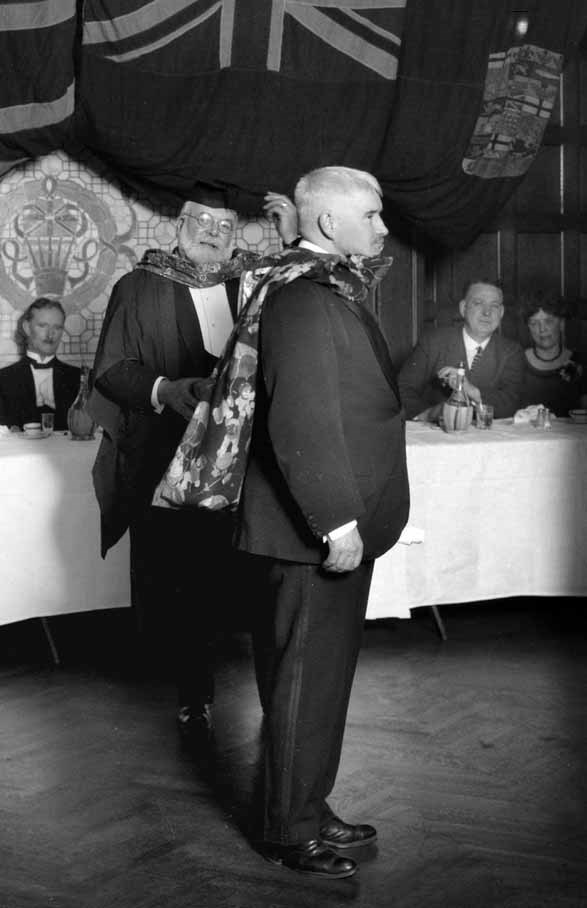A Vancouver time travelogue brought to you by Past Tense.
Colonel Jack Leckie was an engineer and soldier of fortune who fought Boers, Bolsheviks, Huns, and Nazis during his career. He settled in Vancouver in 1910. In 1931, Leckie formed Cocos Island Treasure Limited, persuaded 1800 shareholders to invest, and organized an expedition to the famed island off the coast of Costa Rica to hunt for the oodles of pirate treasure rumoured to be buried there.
On Sunday morning, 21 February 1932, Leckie and his crew waved goodbye to the hundreds of spectators who came out to Pier "D" at the foot of Granville to bid them adieu.
The adventurers, upon whom are pinned the hopes of 1800 shareholders, left in a downpour of rain, oratory, cheers, songs and a few scattered snickers. Movie men ground their cameras, autograph gatherers hurried about with outstretched pencils, some feminine onlookers shed tears, either out of excitement or sympathy.
Ex-mayor and shareholder in the venture, RH Gale, tried to convey his confidence in the mission: “I’m quite sure that they’ll come back, perhaps on a battleship, with the treasure, and if they don’t find the particular treasure they’re after, any other treasure will do.” Acting mayor George Miller was also on hand, giving the departure an official air. If the mission was successful, it would bring "enormous publicity" to Vancouver because Leckie recruited Hollywood filmmakers and other media to report on the quest from Vancouver.
After the boat pulled away, “the crowd on the dock broke up. Newspaper reporters went to get their breakfast, Ald. Miller went to church, and the shareholders went to supplicate the special gods who watch over treasure hunts.”
Leckie was only the latest in a long line of booty-seekers to make the trip to Cocos Island, an uninhabited tropical paradise that was a popular hangout for pirates in the 17th and 18th centuries. The notorious Benito Bonito of the Bloody Sword and other pirates allegedly buried vast treasures there, but the best documented is the lost "Treasure of Lima."
During a revolt in Peru in 1820, the Spanish gathered the fantastic treasures they had accumulated in Lima to send them to Mexico for safekeeping. The Englishman they hired for the task turned pirate, murdered all the Spaniards accompanying him, and headed to Cocos, where he buried the loot. Hundreds of treasure hunters have searched the island over the years, including President FD Roosevelt, Errol Flynn, and Malcolm Campbell. The island was an inspiration for Treasure Island and Jurassic Park.
One of Leckie's party was WS Clayton, another Vancouverite who led his own expedition in 1926. Clayton invented the "metalophone," a metal detector that could detect metal forty feet below the surface. But like Clayton's earlier expedition, Leckie ran out of money before finding any loot. Back in Vancouver, Leckie unsuccessfully tried to raise funds to resume his search. Some of the more cynical thought it was just a money-making scheme designed to "hook the suckers" who invested in Leckie's company.
The next expedition left from Vancouver in 1935 led by another local adventurer named Bud Bellamy, who claimed to have found 133 coins while stranded for a few months on Cocos Island. Bellamy's attempt to return and find the rest of the booty was met with enough misadventure to fill a dime-store novel, and he came back insisting the island treasure was protected by a curse.
Cocos Island is now a UNESCO World Heritage site for its remarkable biodiversity, and Costa Rica no longer allows treasure hunters, with few exceptions. The latest expedition was scheduled to take place earlier this year using 21st century technologies, but so far no results have been reported.
Happy Talk Like a Pirate Day!
Source: Photo of JE Leckie by Stuart Thomson (cropped), 1930, City of Vancouver Archives #CVA 99-2162




